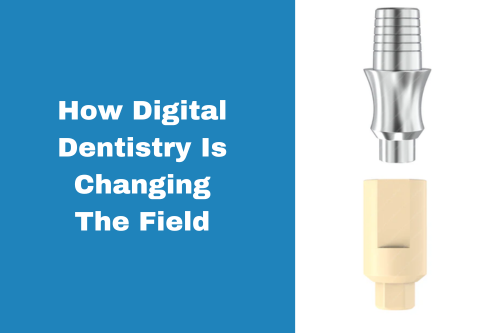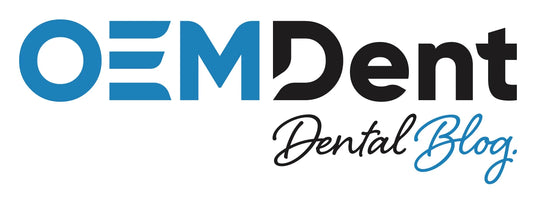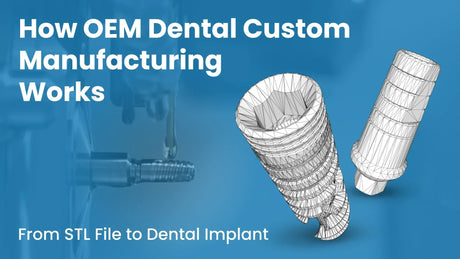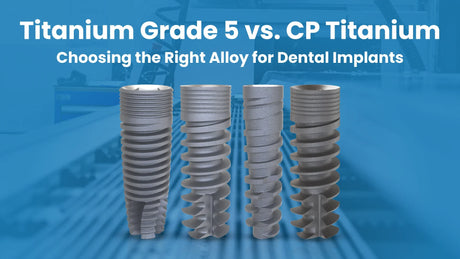

How Digital Workflow Is Changing the Future of Dental Implants
For years, taking implant impressions followed the same routine. A patient would sit in the chair, and we’d fill a tray with thick, sticky impression material. They’d bite down and hold still while it set, hoping they didn’t move or gag. If they did, we had to start over. Then we’d send the impression to the lab, where a model would be made by hand. After waiting days or even weeks, the final prosthesis would arrive. But sometimes, it wouldn’t fit quite right, and we’d have to adjust it or even send it back for a remake.
It worked, but let’s be honest - it wasn’t always smooth, and it certainly wasn’t fast.
Now, imagine a world where this entire process is faster, more accurate, and completely digital. No messy materials, no delays, no guesswork. Instead, a small handheld scanner captures the implant site in seconds, and the data is sent instantly to the lab. The restoration is designed digitally with extreme precision and is ready in a fraction of the time.
This isn’t the future - it’s happening right now, and it’s completely changing how we do implant dentistry.
Why the Old Way Had to Change
Traditional impressions got the job done, but they came with challenges:
-
Messy impression materials that could be uncomfortable for patients
-
Small movements while the material was setting that could distort the final result
-
Material shrinkage or expansion, leading to inaccuracies
-
Waiting for physical impressions to be shipped to the lab and processed
-
Extra appointments if the restoration didn’t fit and needed adjustments
With digital workflow, all of these issues disappear. Instead of physical impressions, we now use intraoral scanners that create a 3D digital model of the patient’s mouth. Instead of waiting for the model to be made, the scan is sent instantly to the lab. Instead of manually sculpting restorations, CAD CAM technology creates them with unmatched precision before they are milled or 3D printed.
Everything is faster, easier, and more predictable - for both the dentist and the patient.
Step Into the Digital Workflow - See It in Action
Let’s walk through a real digital workflow. Imagine a patient is in the chair, and you’re about to take an implant impression. But instead of reaching for an impression tray, you grab an intraoral scanner.
Step 1: Scanning - Instant, Clean, and Ultra Precise
After putting the Scan Body, you position the scanner over the implant site and within seconds, a live 3D image of the patient’s mouth appears on the screen. Every detail of the implant, the surrounding teeth, and the gum tissue is captured instantly.
You can zoom in, rotate the model, and check for any missing details before moving on. If something isn’t quite right, you simply rescan - no need to redo the entire impression.
The patient is comfortable, there’s no mess, and you know the scan is accurate before you send it off.
Step 2: Sending the Scan - No More Delays
Once you’re happy with the scan, you send it directly to the lab with a click. No need to package and ship anything. No risk of the impression distorting in transit. No waiting.
The lab receives the scan instantly and can start designing the restoration right away.
Step 3: Digital Design - Perfecting the Fit Before It’s Even Made
In the past, lab technicians worked with stone models, manually shaping wax ups before casting the final prosthesis. This process took time and allowed for small errors that sometimes led to a poor fit.
Now, everything is done digitally. With CAD CAM technology, the technician designs the restoration on a computer with pinpoint accuracy. The software fine tunes the shape, occlusion, and contact points before fabrication even begins.
This means the final prosthesis is designed to fit perfectly from the start, reducing the need for adjustments.
Step 4: Milling and 3D Printing - Restorations That Fit the First Time
Once the design is ready, the restoration is milled from zirconia, titanium, or PMMA or created using a high tech 3D printer.
Because it was designed digitally, the final restoration is incredibly precise. When the patient comes back for placement, it fits right the first time. There’s no struggle to seat it, no major adjustments needed, and no extra appointments to fix minor errors.
Less stress, less chair time, and a better experience for everyone.
Why Digital Workflows Are the Future
This shift to digital isn’t just about making things faster - it’s about making them better.
-
Patients are happier - No more messy impressions or extra, not so fun, appointments.
-
Accuracy is higher - Digital scans remove distortions and human error.
-
Turnaround times are faster - Restorations are designed and fabricated in days, not weeks.
-
Communication with labs improves - Instant data transfer means fewer mistakes.
-
Less waste, fewer remakes - Digital designs result in a better fit the first time.
With benefits like these, it’s no surprise that more and more dental practices are making the switch.
Are Traditional Impressions Still Needed?
Not every case can be scanned digitally - at least, not yet. Some deep implant sites, tricky angulations, or cases with limited mouth opening may still require traditional impression copings and physical models. But these cases are becoming less common as scanning technology improves.
Many clinics are now using a combination of both methods - digital scans for most cases and traditional impressions when absolutely necessary. But the direction is clear: the future is digital.
The Future of Implant Dentistry is Here
At OEMDent, we believe that digital workflows are not just a passing trend - they are the new standard. That’s why we offer a full range of titanium body scans and CAD CAM compatible components to help clinics make the transition.
If you’re still using traditional impressions for all your cases, now is the time to explore what digital can do for you. The future of implant dentistry is faster, more accurate, and more efficient - and it’s already here.
Why wait? Start embracing digital workflow today and take your implant dentistry to the next level.

OEMDent.com offers uncompromised quality, cost-effective dental implants & prosthetics compatible with leading implant systems. We go beyond manufacturing, offering OEM & Private Label services to meet your dental needs.






